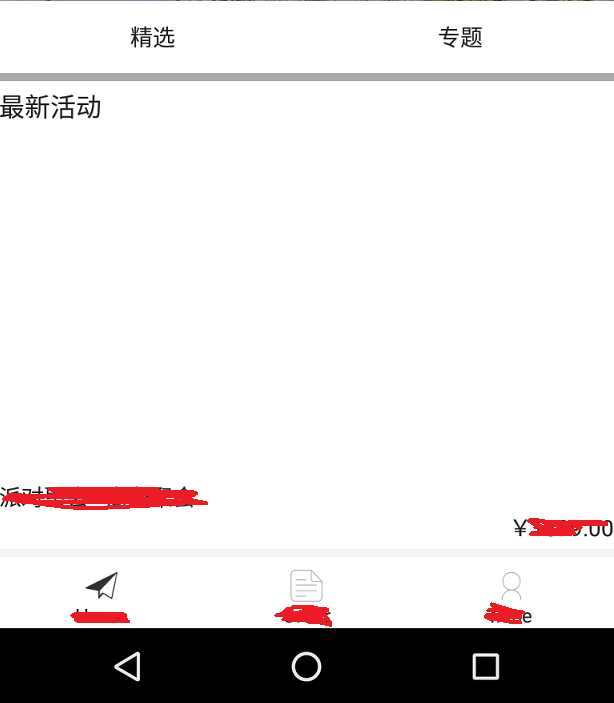标签:util weight xmlns draw cti and 分享 ide lda
由于业务需要,需要在使用Activity的顶部使用一个导航栏,点击导航栏的tab,下面显示内容。决定采用项目中已经使用过的FragmentTabHost + Fragment的方式实现。不同的是之前的FragmentTabHost位于底部(下面统称:Bottom),现在需要放置在顶部(下面统称:Top)。下面将对这两种方式进行比较:
Activity布局文件:
1 <?xml version="1.0" encoding="utf-8"?> 2 <LinearLayout xmlns:android="http://schemas.android.com/apk/res/android" 3 android:id="@+id/activity_main" 4 android:layout_width="match_parent" 5 android:layout_height="match_parent" 6 android:orientation="vertical" > 7 8 <FrameLayout 9 android:id="@+id/content_main" 10 android:layout_width="match_parent" 11 android:layout_height="0dp" 12 android:layout_weight="1" 13 android:background="@color/white"/> 14 15 <android.support.v4.app.FragmentTabHost 16 android:id="@+id/tabHost_main" 17 android:layout_width="match_parent" 18 android:layout_height="wrap_content" 19 android:layout_marginTop="5dp"> 20 <FrameLayout 21 android:id="@+id/tabContent" 22 android:layout_width="match_parent" 23 android:layout_height="wrap_content"/> 24 </android.support.v4.app.FragmentTabHost> 25 26 </LinearLayout>
Activity中设置FragmentTabHost:
protected void initTabs() { fm = getSupportFragmentManager(); layoutInflater = LayoutInflater.from(this); tabLabels = new String[]{ CommonUtil.getStringFromRes(this, R.string.text_tab_promotion), CommonUtil.getStringFromRes(this, R.string.text_tab_order), CommonUtil.getStringFromRes(this, R.string.text_tab_personal) }; tabHost.setup(this, fm, R.id.content_main); for (int i=0; i<fragments.length; i++) { TabHost.TabSpec tabSpec = tabHost.newTabSpec(tabLabels[i]).setIndicator(getTabItemView(i)); tabHost.addTab(tabSpec, fragments[i], null); tabHost.getTabWidget().getChildAt(i).setBackgroundResource(R.color.white); } tabHost.getTabWidget().setDividerDrawable(null); }
显示正常

top方式Activity中对FragmentTabHost的设置跟上面一样,因此只对Layout做对比。
<?xml version="1.0" encoding="utf-8"?> <LinearLayout xmlns:android="http://schemas.android.com/apk/res/android" android:layout_width="match_parent" android:layout_height="match_parent" android:orientation="vertical"> <android.support.v4.app.FragmentTabHost android:id="@+id/tab_host" android:layout_width="match_parent" android:layout_height="40dp"/> <FrameLayout android:id="@+id/fragment_content" android:layout_width="match_parent" android:layout_height="match_parent"/> </LinearLayout>
结果为:

下面的内容,无论tab切换到哪一个,都是空白。针对这种情况,进行断点分析,发现Fragment中的View控件都已经被加载,只是被遮挡住了。
因此,问题应该出在布局上。
偶然的将LinearLayout换成RelativeLayout
<?xml version="1.0" encoding="utf-8"?> <RelativeLayout xmlns:android="http://schemas.android.com/apk/res/android" android:layout_width="match_parent" android:layout_height="match_parent"> <FrameLayout android:layout_marginTop="42dp" android:id="@+id/fragment_content" android:layout_width="match_parent" android:layout_height="match_parent"/> <android.support.v4.app.FragmentTabHost android:id="@+id/tab_host" android:layout_width="match_parent" android:layout_height="40dp"/> </RelativeLayout>
成功:

这里为什么使用LinlearLayout不成功,换成RelativeLayout可以,最终的原因,待研究清楚再总结。
FragmentTabHost + Fragment 使用小记
标签:util weight xmlns draw cti and 分享 ide lda
原文地址:http://www.cnblogs.com/ithaibo-sit/p/6023316.html